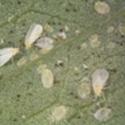This article is helpful in describing and identifying common indoor plant pests. However, it is a bit sketchy and out-of-date in terms of effective treatment of these pests. The author posts a list of various products to be used to treat these pests. All of them are more or less effective depending on how they are applied.
The key to treating all of these pests is THOROUGHNESS of coverage of whatever it is you are applying. Most treatments, with the exception of toxic pesticides, require direct contact with the pests. Many of the tiny juveniles survive between the spray droplets and later reproduce. Wiping will remove many of them, but will miss those that hide in the tiny crevices where leaf stems attach to main stems. Dabbing or picking individual mealybugs or scale insects is an arduous task that is doomed to failure and needs to be retired in the list of treatments.
For nearly all of the pets listed here, a solution of liquid dish soap, alcohol and water can be highly effective with a single treatment, IF YOU ARE THOROUGH. This means that you have to spray the ENTIRE PLANT, including all leaf and stems surfaces, until they are DRIPPING WET. Yes, this is a messy chore, but if you are thorough, you will not have to repeat it.
In many instances, the presence of plant pests is an indication that the plant is under stress for other reasons, usually inadequate light and/or improper watering. It is quite possible to eradicate the pests but lose the plant for other reasons. View plant pests as a warning sign about your cultural practices.
Fungus gnats occur most frequently following repotting. This is because the most popular packaged potting mixes are often contaminated with gnat larvae because they contain soil, humus, compost and bark chips mixed into the peat base. The peat is not the problem. The larvae live in the upper portion of the soil of a potted plant so as adults they can emerge into the open air. Remove all loose soil from the surface that is not in immediate contact with roots. Then allow the soil to dry as deep into the pot as possible, close to the wilt point. This drying process will deprive the larvae of the moisture and decaying organic matter they need to survive. It will also help your plant avoid root rot which is often linked with the presence of gnats.
~Will Creed, Indoor landscaper
